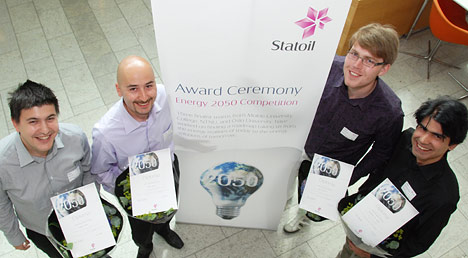
Students Serkan Eren, left, Ahmet Tetik, Boris Mocialov and Muhammad Ali Mohsin captured Statoil’s “Energy 2050” prize with four innovative ideas for making future energy. (Photo: David Burke)
Statoil asked - and got back bundles of clever proposals through its “Energy 2050” competition. The mission: “Come up with sustainable solutions to today’s energy dilemma: the need to make radical reductions in CO2 emissions, and the long term increase in demand for energy”.
A total of 24 teams submitted entries and three finalist teams were selected by a panel of judges last fall. The finalist teams worked on their projects for six months and the winning team was announced Friday, 20 August, during an awards ceremony at Vækerø in Oslo.
Team Trondheim
Boris Mocialov, Muhammad Ali Mohsin and Serkan Eren, students at the Norwegian University of Science and Technology (NTNU) in Trondheim, Norway, and Ahmet Tetik, student at Sør-Trøndelag University College, also Trondheim, captured the jury’s imagination with a comprehensive 30-page essay on not one, but four ideas to generate renewable power by 2050.
“This is fantastic. Thank you! The experiences we’ve had leading up to the prize have provided opportunities to a learn a great deal more and to work inside a huge company while we’re still students,” says Mocialov.
All winners
Second and third place teams are, respectively, the University of Oslo and Molde University College.
The grand prize winners will travel by helicopter to Statoil’s Statfjord A offshore platform and get to present their ideas on 24 August at Statoil’s stand at the Offshore Northern Seas (ONS) 2010 conference and exhibition in Stavanger, 24-27 August.
The second and third place winners get to visit Statoil’s Hywind project and the Kårstø facility.
Road ahead
Team NTNU entitled their proposal “A letter to the past – Roadmap towards 2050”.
The first concept, called “Green dream housing” consists of generating household power from methane gas sourced from bio-degradable solid waste produced in the home. Small power generation facilities would be situated under the home.
Idea number two, called “e motion”, embraces kinetic energy, or power derived from motion. The concept sources electricity from the movement of vehicles on roads, as well as revolving doors, sport facilities, amusement parks, etc. The team even takes it a step further, literally, by sourcing kinetic energy from shoes. The power produced by walking can be used in mobile electrical gear.
The third idea, called “Mag-ine” revolves around magnetic energy, in other words, power derived from the perpetual motion of opposing magnetic poles that is used to drive parts in machines.
Concept number four, called “Hybrid wind, wave and solar energy” combines and harvests the infinitely renewable power sources to drive industrial facilities.
“This work has provided us a good opportunity to work further with our ideas and to make a positive contribution to the world,” says Mohsin.
Asked if they’d consider starting their professional careers in the oil and gas industry, all four nod their heads.
“That’d be great actually,” says Tetik.